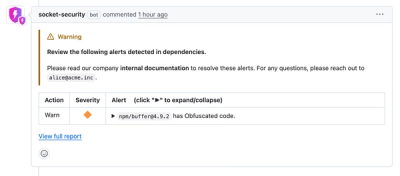
Security News
Crates.io Users Targeted by Phishing Emails
The Rust Security Response WG is warning of phishing emails from rustfoundation.dev targeting crates.io users.
ep_webrtc
Advanced tools
WebRTC-based audio/video chat and screen sharing with other users visiting the same pad.
The audio and video streams are peer-to-peer: every user sends a copy of their audio/video streams directly to every other user visiting the same pad. Because of this, it works well for small groups (2 to 4 users, more if video is disabled or everyone has fast Internet connections) but not for large groups.
/admin interface, search for ep_webrtc, and click
Install.cd /path/to/etherpad
npm install --no-save --legacy-peer-deps ep_webrtc
cd /path/to/etherpad/node_modules
git clone https://github.com/ether/ep_webrtc
In the settings menu there is a toggle to turn the plugin on and off for the
user. When toggled, its state is saved in a cookie and applied when any pad is
visited. The value can also be changed by adding av=true or av=false to the
URL query parameters.
The default value for this setting can be controlled in the server's
settings.json file (it defaults to true):
"ep_webrtc": {
"enabled": true
}
The settings menu also contains separate toggles for starting video and audio sharing when the plugin is enabled. When toggled, their state is saved in a cookie and applied when any pad is visited. They can also be changed by adding the following to the URL query parameters:
webrtcaudioenabled=truewebrtcaudioenabled=falsewebrtcvideoenabled=truewebrtcvideoenabled=falseThe default value can be controlled in the server's settings.json file:
"ep_webrtc": {
"audio": {
"disabled": "none"
},
"video": {
"disabled": "none"
}
}
Supported values for "disabled":
"none" (the default): Initially enabled by default."soft": Initially disabled by default."hard": Unavailable (it cannot be enabled).The misnamed listenClass setting allows you to specify a CSS selector for an
element (or elements) that will activate the plugin when clicked. This is
usually combined with "enabled": false. Example:
"ep_webrtc": {
"enabled": false,
"listenClass": "#startVideoSessionButton"
}
By default, this plugin uses Google's STUN servers. To use custom STUN/TURN
servers, set ep_webrtc.iceServers in your settings.json to a list of
RTCIceServer
objects:
"ep_webrtc": {
"iceServers": [
{"urls": ["stun:stun.l.google.com:19302"]}
]
}
Include a TURN server to support users behind symmetric NAT devices. For example:
"ep_webrtc": {
"iceServers": [
{
"urls": ["stun:stun.l.google.com:19302"]
},
{
"urls": ["turn:turn.example.com:3478"],
"username": "the_username",
"credential": "the_password"
}
]
}
To limit abuse, the coturn TURN server supports ephemeral (temporary) usernames and passwords. To take advantage of this feature, configure your TURN entry as follows:
credentialType: Must be set to the exact string "coturn ephemeral password".username: Ignored. (The username that will be sent to the TURN server is
dynamically generated and based on the user's Etherpad-generated author ID.)credential: Must be set to coturn's static-auth-secret
setting.lifetime: How long (in seconds) the password will remain valid after the
user visits a pad. After this amount of time, new TURN connections will fail
until the user reloads the page (which will generate a new password). Defaults
to 43200 (12 hours).Example:
"ep_webrtc": {
"iceServers": [
{
"urls": ["stun:stun.l.google.com:19302"]
},
{
"urls": ["turn:coturn.example.com:3478"],
"credentialType": "coturn ephemeral password",
"credential": "your_coturn_secret",
"lifetime": 3600
}
]
},
There is also support for ephemeral credentials from the Xirsys API:
credentialType (required): Must be set to the exact string "xirsys ephemeral credentials".url (required): The desired Xirsys TURN API endpoint.username (required): Your Xirsys username.credential (required): Your Xirsys API secret.lifetime (optional; defaults to 43200 = 12 hours): How long (in seconds)
the ephemeral credentials will remain valid after the user visits a pad.
After this amount of time, new TURN connections will fail until the user
reloads the page (which will generate a new password).Example:
"ep_webrtc": {
"iceServers": [
{
"credentialType": "xirsys ephemeral credentials",
"url": "https://global.xirsys.net/_turn/myChannel",
"username": "myUsername",
"credential": "myPassword",
"lifetime": 3600
}
]
},
To spread load across multiple TURN services, you can enable sharding:
"ep_webrtc": {
"iceServers": [
{"urls": ["stun:shard0.example.com", "turn:shard0.example.com"]},
{"urls": ["stun:shard1.example.com", "turn:shard1.example.com"]},
{"urls": ["stun:shard2.example.com", "turn:shard2.example.com"]},
{"urls": ["stun:shard3.example.com", "turn:shard3.example.com"]},
],
"shardIceServers": true
},
When shardIceServers is false (the default), all clients receive all
RTCIceServer objects in the iceServers list and it's up to the browser to
figure out how to use them to connect with peers. When true, this plugin
assigns a single entry from iceServers to each pad and gives out only that
assigned entry to users that connect to the pad. The intention is to provide a
better guarantee of load distribution across a set of TURN servers, and to avoid
an unnecessary network hop when both peers are configured to force the use of
TURN.
The microphone can be configured by setting audio.constraints to any audio
constraints
value acceptable to client browsers. It has the following default value:
"ep_webrtc": {
"audio": {
"constraints": {
"autoGainControl": {"ideal": true},
"echoCancellation": {"ideal": true},
"noiseSuppression": {"ideal": true}
}
}
},
For a full list of available constraints, see the standard.
The camera's record resolution can be configured by setting video.constraints
to any video
constraints
value acceptable to client browsers. It has the following default value:
"ep_webrtc": {
"video": {
"constraints": {
"width": {"ideal": 160},
"height": {"ideal": 120}
}
}
},
For a full list of available constraints, see the standard.
Changing the record resolution does not change the size of the displayed video
widgets. To change the video widget size, set video.sizes.small and/or
video.sizes.large:
"ep_webrtc": {
"video": {
"sizes": {
"small": 200,
"large": 400
}
}
},
You can see metrics for various errors that users have when attempting to connect their camera/microphone:
ep_webrtc_err_Hardware: Some sort of hardware-related connection problem on
the users' computer.ep_webrtc_err_NotFound: Could not find user's camera/microphone.ep_webrtc_err_Abort: Some sort of other, non-hardware related connection
problem on the user's computer.ep_webrtc_err_Permission: User did not grant permission to their
camera/microphone.ep_webrtc_err_SecureConnection: Etherpad is not set up on a secure
connection, which is requried for WebRTC.ep_webrtc_err_Unknown: Some other unspecified error. Perhaps a bug in this
plugin.If you're just working on the interface and don't need to test connections to
other computers, you can point your browser to localhost instead of 0.0.0.0.
WebRTC generally requires a secure connection (https), but an exception is
made specifically
for localhost and domains that end in .localhost.
If you need to test communication, you may get away with opening two browser
windows to the same URL on localhost. However this may be of limited utility,
especially if you're confirming that sound works appropriately. In order to test
on two computers, you'll need your dev computer to serve on an IP address
accessible from the other computer, at which point you will no longer get away
with using localhost. You will need SSL certs, though for dev purposes they
can be self-signed.
Generate your certificate, which will give
you your cert and key files. In settings.js, set the full path to them on your
file system:
"ssl": {
"key": "/path-to-your/epl-server.key",
"cert": "/path-to-your/epl-server.crt"
// "ca" - not needed for dev purposes
}
Point your browser to your outward facing IP address, preceeded by https://,
and accept the security warning (since this is a self-signed cert).
Please submit bug reports or patches at https://github.com/ether/ep_webrtc/issues
FAQs
WebRTC based audio/video chat to Etherpad
The npm package ep_webrtc receives a total of 1,819 weekly downloads. As such, ep_webrtc popularity was classified as popular.
We found that ep_webrtc demonstrated a healthy version release cadence and project activity because the last version was released less than a year ago. It has 6 open source maintainers collaborating on the project.
Did you know?

Socket for GitHub automatically highlights issues in each pull request and monitors the health of all your open source dependencies. Discover the contents of your packages and block harmful activity before you install or update your dependencies.

Security News
The Rust Security Response WG is warning of phishing emails from rustfoundation.dev targeting crates.io users.

Product
Socket now lets you customize pull request alert headers, helping security teams share clear guidance right in PRs to speed reviews and reduce back-and-forth.

Product
Socket's Rust support is moving to Beta: all users can scan Cargo projects and generate SBOMs, including Cargo.toml-only crates, with Rust-aware supply chain checks.